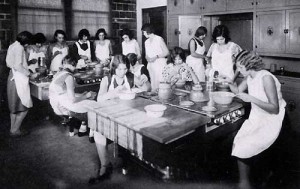
Although principles of domesticity were being taught as early as the mid 19th century, the term “home economics” was not applied to this area of study until the early 20th century. An increasingly literate population and the greater availability of printed materials in the 19th century catalyzed the consumption of literature on homemaking. Furthermore, in 1862, the Morrill Act was passed, establishing land-grant colleges in each state that were open to women, and that were mandated to foster research and instruction in practical areas of endeavor. At this time, the application of scientific theories and techniques modernized activities associated with home economics, such as cooking, laundry, sewing, housecleaning, care of the sick, and sanitation. This in turn led to the implementation of courses in “domestic science” at the end of the nineteenth century. In 1899, with the establishment of the Lake Placid Conferences, the term “home economics” was decided upon and activists began to call for the teaching of home economics in schools across the country. In 1908, conference participants formed the American Home Economics Association which went on to lobby federal and state governments for funding to facilitate the research and teaching of home economics.
In 1917, the Smith-Hughes Act mandated an emphasis on and provided funding for occupational preparation in home economics classes. Although this act undermined and codified gender roles in the field of home economics, it also established an important link between the federal government and the field of home economics which “sought to elevate and enlarge women’s roles in the home and in society” (Stage 79). The study of home economics aimed to “prepare student[s] for effective discharge of duties within the home and give scientific preparation for efficient administration of household affairs” (Calvin 1). Home economics also gained popularity in response to the perceived breakdown in society in the early 1900’s as a result of urbanization, industrialization, and immigration.
The Vocational Education Act of 1963 diminished the funding that the field had been receiving from the Smith-Hughes Act. Funding was only to be provided for home economics education that lead to gainful employment. Relatedly, in the 1960s and 1970s, home economics came under fire with changing societal norms for women at home and in the workplace. Many schools dropped these programs and in some cases the educators of this profession were criticized for their lack of sympathy towards modern feminism. However, home economics legitimately created opportunities for women and greatly impacted American society, creating vocational and economic opportunities for women and educating boys and men about domestic skills.